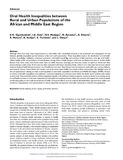| dc.contributor.author | Ogunbodede, EO | |
| dc.contributor.author | Kida2, IA | |
| dc.contributor.author | Madjapa2, HS | |
| dc.contributor.author | Amedari, M. | |
| dc.contributor.author | Ehizele, A | |
| dc.contributor.author | Mutave, R | |
| dc.contributor.author | Sodipo, B. | |
| dc.contributor.author | Temilola, S. | |
| dc.contributor.author | Okoye, L. | |
| dc.date.accessioned | 2015-07-01T09:31:17Z | |
| dc.date.available | 2015-07-01T09:31:17Z | |
| dc.date.issued | 2015-06-29 | |
| dc.identifier.uri | Ogunbodede, E. O., Kida, I. A., Madjapa, H. S., Amedari, M., Ehizele, A., Mutave, R., ... & Okoye, L. (2015). Oral Health Inequalities between Rural and Urban Populations of the African and Middle East Region. Advances in Dental Research, 27(1), 18-25. | |
| dc.identifier.uri | http://hdl.handle.net/11295/85858 | |
| dc.description.abstract | Although there have been major improvements in oral health, with remarkable advances in the prevention and management of oral
diseases, globally, inequalities persist between urban and rural communities. These inequalities exist in the distribution of oral health
services, accessibility, utilization, treatment outcomes, oral health knowledge and practices, health insurance coverage, oral health–
related quality of life, and prevalence of oral diseases, among others. People living in rural areas are likely to be poorer, be less health
literate, have more caries, have fewer teeth, have no health insurance coverage, and have less money to spend on dental care than
persons living in urban areas. Rural areas are often associated with lower education levels, which in turn have been found to be related
to lower levels of health literacy and poor use of health care services. These factors have an impact on oral health care, service delivery,
and research. Hence, unmet dental care remains one of the most urgent health care needs in these communities. We highlight some of
the conceptual issues relating to urban-rural inequalities in oral health, especially in the African and Middle East Region (AMER). Actions
to reduce oral health inequalities and ameliorate rural-urban disparity are necessary both within the health sector and the wider policy
environment. Recommended actions include population-specific oral health promotion programs, measures aimed at increasing access
to oral health services in rural areas, integration of oral health into existing primary health care services, and support for research aimed
at informing policy on the social determinants of health. Concerted efforts must be made by all stakeholders (governments, health care
workforce, organizations, and communities) to reduce disparities and improve oral health outcomes in underserved populations | en_US |
| dc.language.iso | en | en_US |
| dc.publisher | University of Nairobi | en_US |
| dc.subject | dental, disparity, access, equity, prevention, poverty | en_US |
| dc.title | Oral health inequalities between rural and urban populations of the African and middle East region | en_US |
| dc.type | Article | en_US |
| dc.type.material | en_US | en_US |

